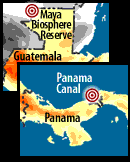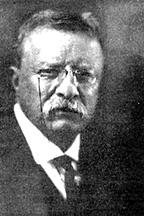|








|
 |
Pick a Region:.
. Central America

Pre-Columbian History
Archaeologists have found evidence of human life in Central America
dating as far back as several thousand years BCE. By the beginning
of the Christian era, Central America had a wide array of indigenous
peoples. Around 250 CE the classical Maya civilization began to emerge
in northern Central America. It controlled much of southern Mexico,
Guatemala, El Salvador, and Honduras. The Maya were quite advanced
in mathematics, astronomy, and art. In some of these areas, they were
more advanced than European and Egyptian civilizations. Around the
year 900 CE, the Maya civilization began to decline.
 Spanish
Arrival Spanish
Arrival
In 1502, Christopher Columbus sailed off the coast of Panama. Soon
after, Vasco Núñez de Balboa arrived in Panama and then Hernán Cortés
arrived in Mexico (later traveling as far South as Honduras). The
Spanish arrived and planned to seek wealth and to convert Indians
to Christianity. The arrival of the Spanish marks the beginning of
what is called the Colonial period. Photo:
Portrait of Hernando Cortés.
Photo © 1999 - www.arttoday.com
The Colonial Period
To make control of the New World easier, the Spanish divided it up
into viceroyalties. Guatemala, Honduras,
El Salvador, Nicaragua, and Costa Rica became part of the Kingdom
of Guatemala (which along with Mexico and Belize made up the Viceroyalty
of New Spain). Panama, however, became a province in the Viceroyalty
of New Granada.
Spaniards did well in colonial
Central America as they were employed in the important jobs. However,
the indigenous peoples of Central America did not do as well. In fact,
the colonial period was quite disasterous for them. Most of the Indians
either died from European diseases, such as smallpox, or were subjugated by
the Spaniards to back-breaking labor. In the middle of the social
structure were the mestizos or ladinos,
who worked as wage laborers, merchants, artisans, etc.
 Independence Independence
The Colonial period came to an end in 1821 when Guatemala, El Salvador,
Honduras, Nicaragua, and Costa Rica became independent. From 1823-1838,
these five countries formed the United Provinces
of Central America.
In 1821, Panama declared
its independence from Spain, but until 1903 it was a province of Colombia.
Panama’s independence from Colombia in 1903 was assisted by Theodore
Roosevelt, who was very interested in creating a canal through Panama
(see Panama Canal). Within the
Central American countries, the 1800s were characterized by fighting
between Liberals and Conservatives (see Politics).
Photo: Portrait of Theodore
Roosevelt. Photo © 1999 - www.arttoday.com
The 20th Century
As Central America entered the 20th century, it became increasingly reliant on coffee and
bananas as exports. This reliance further integrated Central America into the global
economy. Throughout Central America, land ownership and distribution of income were very
unequal (see Economics). To an extent, Costa Rica is an
exception, since its economy is much better than most of the other countries of Central
America.
Another characteristic
of Central America has been the relative absence of democracy. Powerful
dictators have dominated Central America throughout much of this century.
The Cold War complicated matters in Central
America as the Soviet Union and the United States competed for influence
throughout the region, especially in Guatemala, El Salvador, and Nicaragua.
These Cold War conflicts have gradually ended in the years since the
Soviet Union dissolved.
|
 |



    
|

